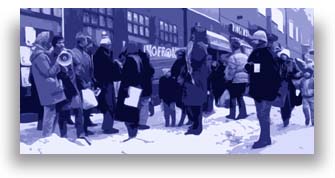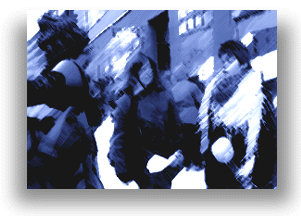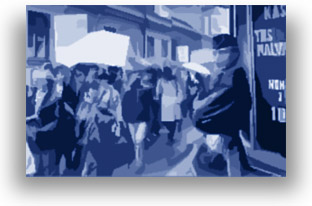|


In 1971 the old "Violation of Discipline and Morality"
Act was abolished in Sweden. Pornography fell within the range of
that act. Sweden was thereby one of the first countries in the word
to lift all restrictions on pornography. Because of this Sweden
became a symbol of pornography, the perfect country for the porn
industry, and all over the world proponents of pornography used
the "liberated" Swedish people as an argument for the
restrictions on pornography to be lifted in their countries as well.
But people in Sweden didn't want this
abolition.
 (You
can read more about the debate in Sweden in these years – especially
on Child Pornography – if you chose "The Politicians &
the Legislation" beneath "Pamphlet" in the menu to
the left, or by clicking HERE.) (You
can read more about the debate in Sweden in these years – especially
on Child Pornography – if you chose "The Politicians &
the Legislation" beneath "Pamphlet" in the menu to
the left, or by clicking HERE.)
Against Puritanism, Morality laws & Pornography
Although many people in Sweden wanted all legislation based on puritanism
and morality to be abolished, the total abolition of the pornography
laws was not what they wanted. Most people wanted some limits, and
they definitely wanted at least child pornography to be prohibited.
At this time, as well as now, women
held the most negative attitudes towards pornography. But women's
opposition to pornography was explained away by the authorities
with comments to the effect that women are more "inhibited
and puritanical". They thereby refused to see that pornography
is another side of puritanism.
With this "setting free"
of pornography, as the sexual liberals called it, even child sexual
abuse was sanctioned by society.
A broad opposition to Pornography
Many people saw how the porn industry expanded in the early 1970s
and wanted to fight against it. Riksaktionen
mot Pornografi och Prostitution (the National Action against
Pornography and Prostitution) was built. It gathered people from
the civil rights movement, the women's movement, political organizations
and the church. They demanded laws against primarily child, animal
and violent pornography.
After several years of lobbying the
law was changed and the making and spreading of Child Pornography
was prohibited from 1980. But this also led to the end of the organization.

A feminist analysis on Pornography
During this period, the 1970s, women started to form groups for
consciousness-raising, the women's shelter movement grew and so
did support groups for incest survivors. The experiences they had
gave women new knowledge on pornography and men's sexual abuse in
all.
The women's movement had already criticized
Riksaktionen for the lack of analysis of pornography as oppression
of women and for it's focus on law and justice. After some years
when everyone tried to fight pornography within the limits of their
own organizations, Kvinnofronten
(The Women's Front) in 1985 took the initiative to build another
broad organization, this time based on a feminist analysis of pornography.
Folkaktionen mot Pornografi
– FmP (The People's Organisation against Pornography).
A year later FmP gathered more than
100 organizations and more than 40 local groups around the country.
Changing of the laws
The struggle against pornography now led to a another change in
the law. From 1989 is is forbidden to make and spread pornography
that involves violence or coercion. Unfortunately practically nothing
is considered "violent" or "coercive" in the
eyes of the justice, so the law is not used. (You can read more
about this if you chose "Society" beneath "Pamphlet"
in the menu to the left, or by clicking HERE.)
In the beginning of the 1990s the
police made some substantial confiscations of child pornography,
which put the light on the fact that possession
of Child Pornography was not prohibited in Sweden. This led to the
forming of a governmental Child Pornography Committee that should
present suggestions for alterations in the Child Pornography Act.
In spite of the fact that the Committee did not suggest a great
change of the Child Pornography Act, the politicians had to change
it – or commit political suicide. So Child Pornography is now
totally forbidden in Sweden.
As more and more people began to see
the consequences of men's sexual abuse against women and children
in a patriarchal society, the laws has been changed on prostitution,
rape and other sexual crimes. We now also have a debate on whether
the making of commercial pornography, as well as the arranging of
porn shows in porn clubs, should be considered crimes included in
the law against pimping.

To make people see
Hopefully the changing of the laws will also change the way people
around the world look upon Sweden. We're trying to rub out the image
of our country as the symbol of pornography.
But FmP did much more than only initiated
a change in the laws: we made people see what was going on.
Now one could think everything is
going in the right direction, but that's not the whole truth. During
the 1990s, at the same time as many people became aware of pornography
as sexual abuse, the sexual liberals have increased in numbers.
They either say pornography is only fantasy or that the women used
in pornography want this to be done to them. We now have women who
call themselves feminists advocating for pornography and prostitution.
S/m is considered chic among many intellectuals and the common pornography
is widespread. The porn industry keeps making its money.
The struggle goes on
At the end of the 1990s FmP came to work too much with rules and
regulations, and the organization diminished and was ended in 1999.
Once again everyone now tries to fight pornography within the limits
of their own organizations.
Time will show what's going to happen
next.
|